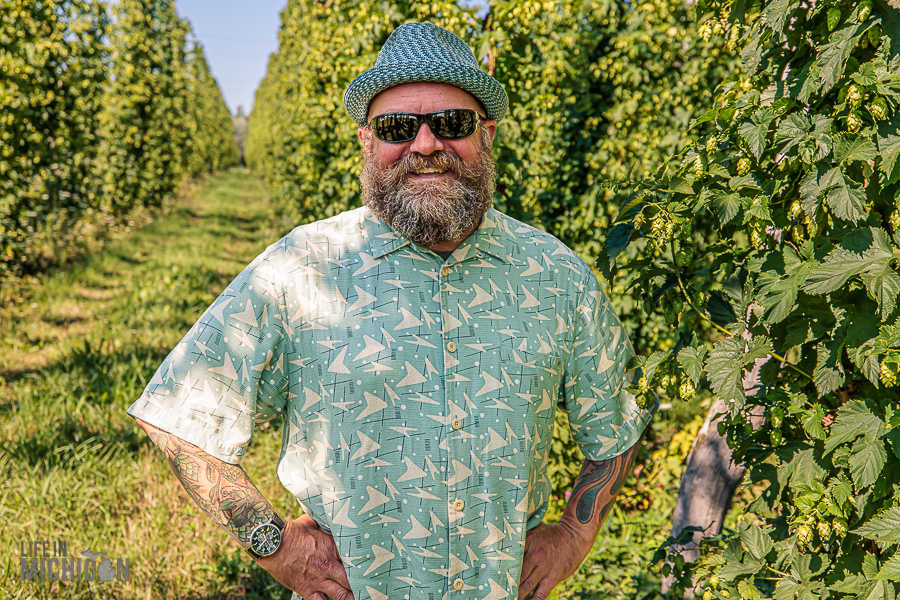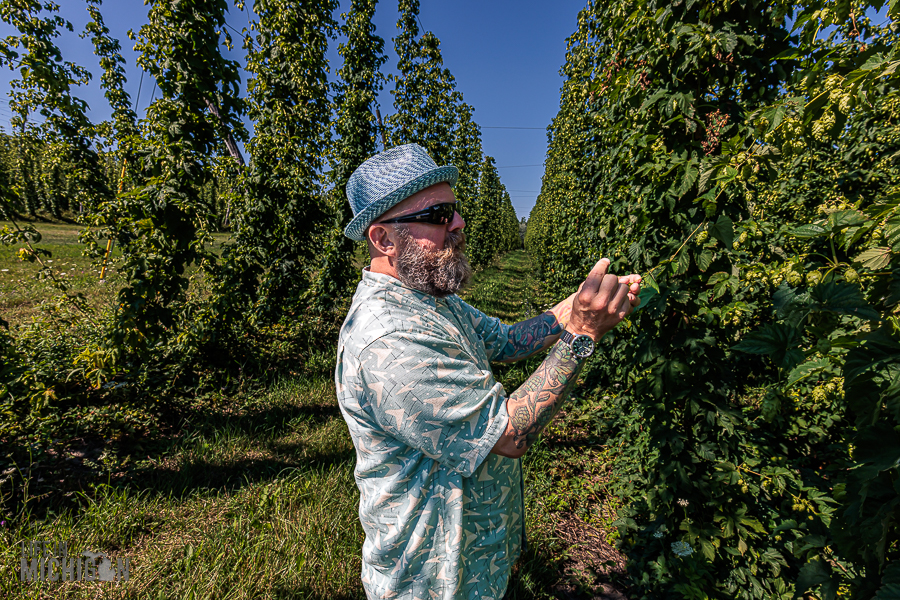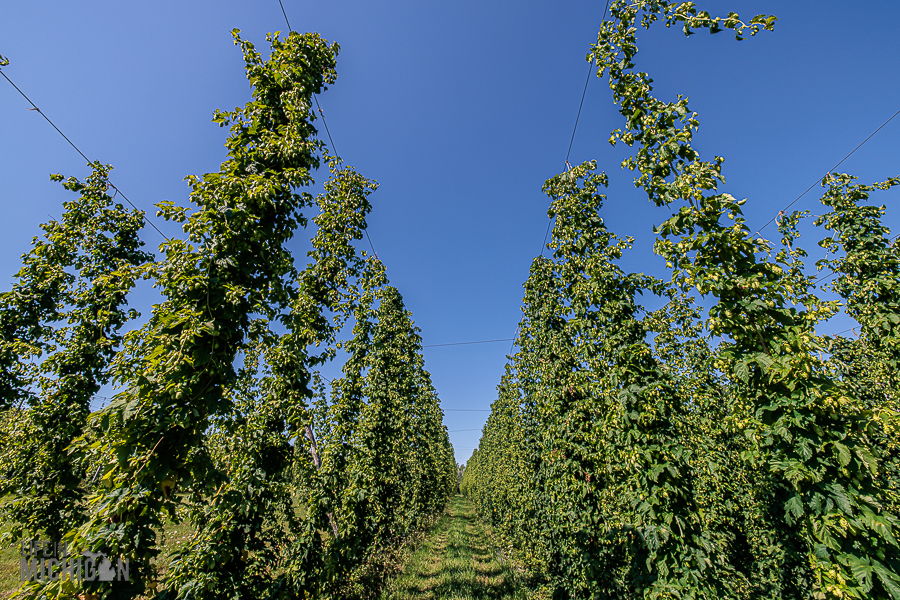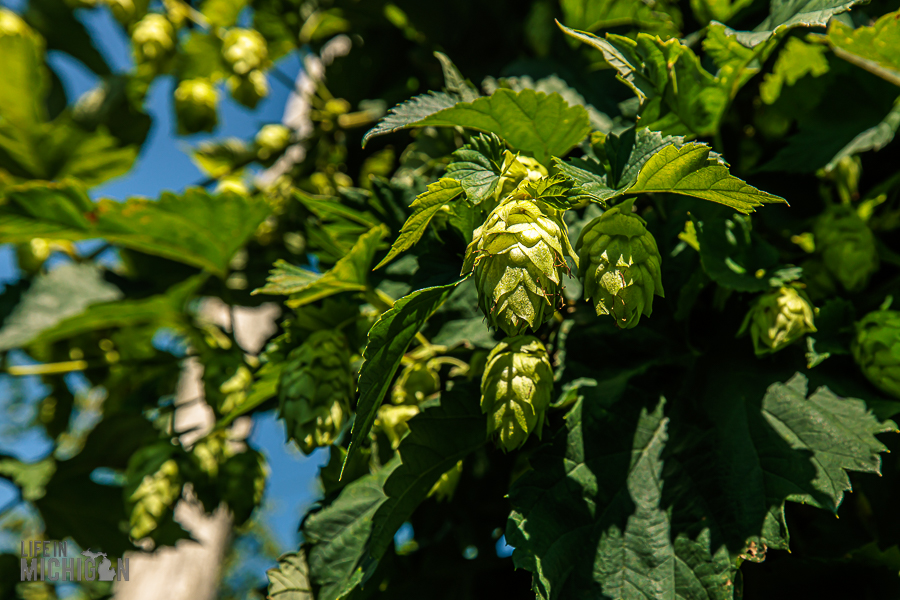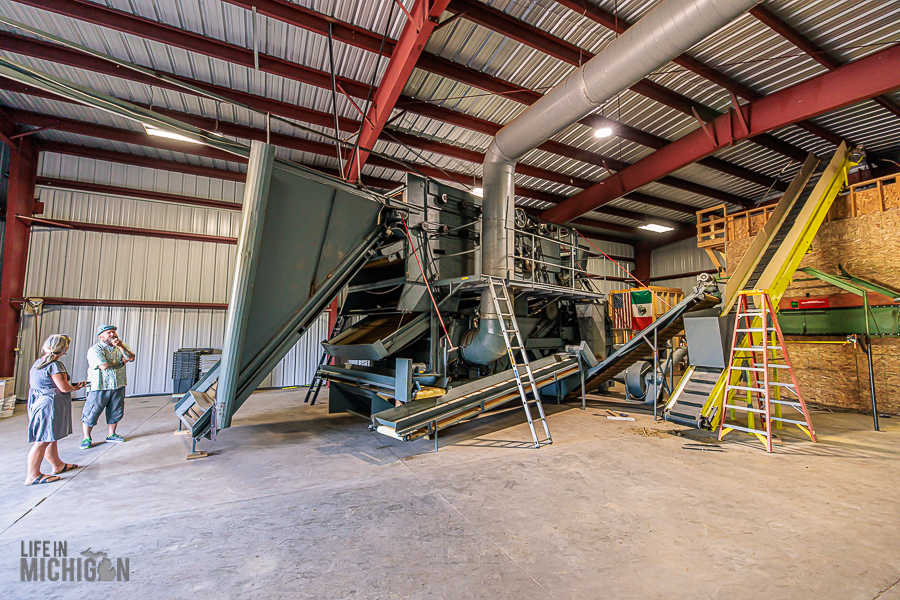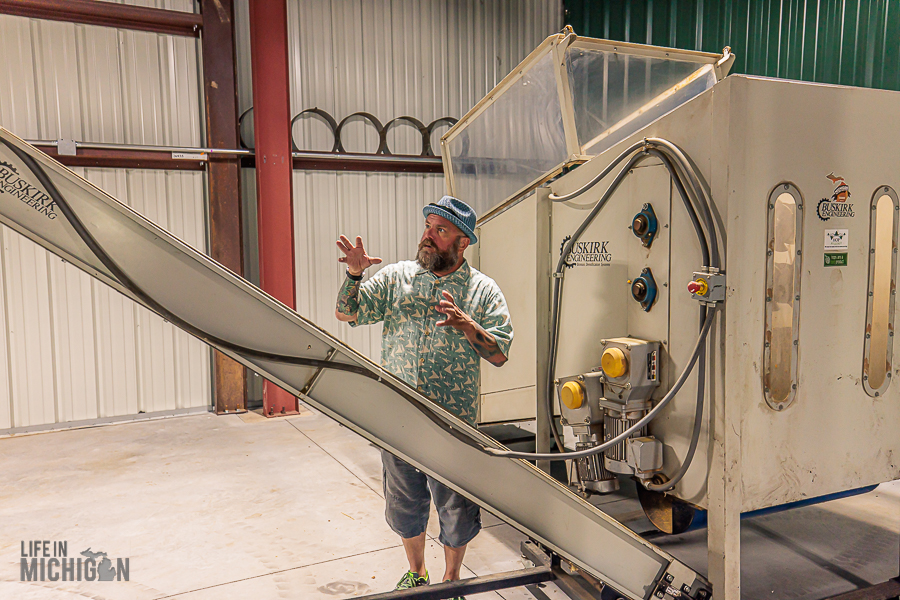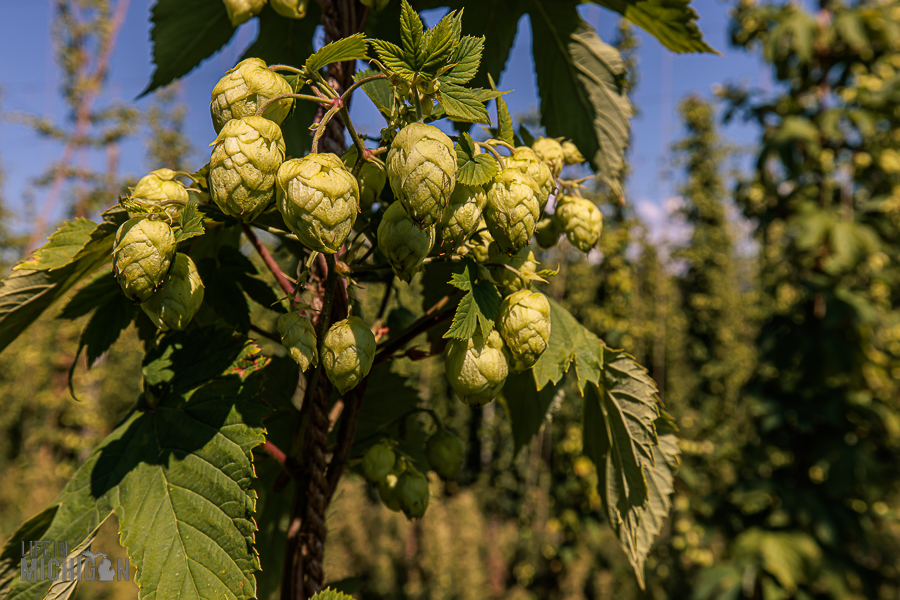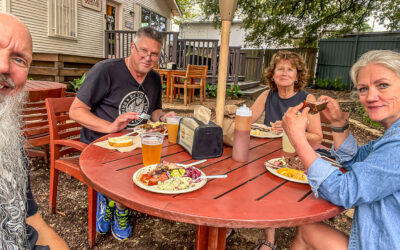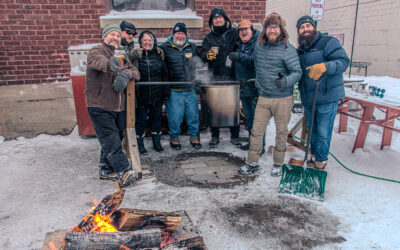Hop Alliance in Omena, Michigan, maybe be small, but as they say, “our cones are big.” This 30-acre farm located at the tip Leelanau Penninsula is anything but small.
Hop Alliance is Hopping
We visited Hop Alliance in early August, days before the harvest started. The quiet before the storm. The lull gave Brian Tennis, Hop Alliance founder, time to give us a hop lesson.
First Hop Alliance is a bit more than a hop farm. Not only do they process hops for other farmers, but it is also a hop brokerage. As a hop broker, they are bringing hops in from places like New Zealand and Germany but also selling Michigan Hops.
Between 200-250 Michigan breweries buy hops from Hop Alliance. Another 3000 breweries outside of Michigan also get their hops from Hop Alliance. In fact, they ship to all 50 states, including Hawaii.
Brian said, “It’s funny to see somebody in California order, Michigan Chinook. It’s weird. We sell a lot to California, even Oregon, and Washington state. That’s where they grow 60,000 acres of hops, and we’re still shipping hops from Michigan out there.”
“We do a lot of business with New Zealand. There’s a farm there called Pikimai. Everything they grow, we buy. We import from nine different countries. I think our next step is going to be exporting. We do a little bit to South America and Brazil and a few other places. I think Mexico and Canada is obviously a likely expansion,” Brain said.
The Hops Guy
“I’m curious whether you ever thought you would be the hop guy,” I asked Brian. “No, and the weird thing is we didn’t get into it to be hop merchants. A lot of brewers were asking us for a proprietary variety we can’t grow. That’s probably the biggest problem about growing hops outside the Pacific Northwest. You’re not going to get the rights to grow like a Simco or a Citra. Amarillo. You can’t even buy the rights to it.
The guys in the Pacific Northwest, they’ve got so much acreage. They don’t want to give out the roots to somebody in Michigan to grow. You could grow a Citra in Michigan, but it tastes different from hops in the Pacific Northwest.
Citra is grown in Washington, Oregon, and Idaho. You can definitely tell the difference between those three states. It would be interesting to see what happens if it was grown in Michigan. I would love to do it.”
Summit Hops
Pointing to the field behind Brian, I asked, “What happened over there?”
He answered, “A conglomerate came in last year and bought all the rights to Summit Hops. They said, okay, the farmers growing it, you have to rip it all out. We were lucky enough to grow it for like eight or ten years. We had to pay royalty on it, not a ton. We ripped it all out last month and put in a conventional trellis. Then we’re going to tie all this in next year, hopefully.”
“What do you mean by tie it in?” I asked.
“If you look at our spacing, our rows are screwy. When we first started, we were experimenting with the USDA and MSU, trying to figure out what would be the perfect width for your drive rows. Some of our spacing is 20 feet, which is just way too much. We can compress them a little bit and get more yield,” Brian said, looking at the field in question.
Starting a Hop Farm
“How did you convince your wife to buy a hop farm?” I asked Brian.
“Honestly, we were camping. We would come up here all the time on vacation from Grand Rapids. We fell in love with the area. The cheapest piece of property that we could find around was 10 acres in Omena. That’s really how it started.
And then they’re like, well, the cherry trees on your property, you either have to take care of them or push them out. Because it’s a state law or county law that if you have fruit or whatever, you’ve got to maintain it. If you don’t, it attracts pests and can impact your neighbors. If you let it go to hell, then it’s your neighbor’s problem.”
I said to Brian, “You must be a risk taker.”
“Our motto is no plan B. It’s got to work,” Brian replied.
Row after row of hops has replaced the cherry trees. Brian formed Hop Alliance in 2010 to process his own hops, as well as hops grown at other reputable farms across Northern Michigan.
Brian said, “We could do everything, palletize, vacuum pack, and marketing. I think that’s why we’re still here. There were so many farmers in the state that just wanted to grow. They didn’t want to do any marketing, and they didn’t have the processing equipment either. They grew a fantastic crop, and then it’s like, well, what do we do now? They didn’t have a picker. They didn’t have a dryer, a baler, any of that stuff.”
How Many Acres
“How many acres did you start with?” I wondered if starting a hop farm might be a good retirement project.
“We just planted one acre 15 years ago. Now, this is a 30-acre farm. Still, everything we grew here last year was sold by February. We’re looking for more land around here, but since COVID, the prices up here (Omena, Michigan) are astronomical for land because everybody wants to get out of the city. They want to be in paradise with us, which is great. It’s making the raw land prices unattainable and unaffordable, unfortunately.”
“Hop farmers should have at least 10 acres. Just an acre or two, it doesn’t make financial sense,” he replied. “You’re not going to buy a used Wolf picker for $35,000 to pick an acre of hops. Then you have to have a dryer and hopefully a baler. You know, that adds up. You’ll have to have a barn, a tractor, and spray equipment. You could drop a hundred grand easy. It’s $10,000 to $15,000 per acre to plant, and you have to have irrigation. It gets expensive fast.”
Location, Location, Location
“Does the location of the hop farm matter?” I asked Brian. “The cool thing is we’re right on the 45th parallel, which is the sweet spot for hops.”
Pro tip: Other areas known for their hops, like Yakima Valley and Germany, are on the 45th parallel. It is the same in the Southern hemisphere for New Zealand and Australia.
“What is special about the 45th parallel?” I asked Brian.
“Here we get enough rain, but it’s the day lengths. People are trying to grow them (hops) in Florida. I don’t think it’s financially viable to do that. We’ve got the right day lengths and just the perfect conditions for it. You’ve got to have well-drained soil. That’s part of the key up here is it’s sandy. We don’t have hardly any clay at this spot. It’s perfect the soil the glaciers left.”
Putting Down Roots
“Are hop plants like grape vines? Do they need years to get established?” I asked.
“We’ll start the plants in a greenhouse instead of using rhizomes which will take a good two to three years to get going. Whereas if you put in a half-gallon pot of hops into the yard, you can get a decent yield the second year. They’re perennial, so you cut them down to the ground every year. It’s not like a grapevine; some of those roots look like tree trunks after 50 years.”
Brian gestured towards the hop yard, saying, “Everything is on trickle irrigation. Grape vines, after maybe the first year, you don’t have to water them. They stress grape vines out a little bit. They want those roots to go in search of water. Hops like to be moist, but they don’t like to get their feet wet, if that makes sense. Hop plants drink a couple of gallons per plant every day. They don’t want to sit in that water.”
Michigan Hops
What hops can Michigan hop farmers grow thinking about the Summit hops Brian had to rip out? “Michigan Chinook is probably the most in-demand hop we have that’s a public variety. It’s because it’s got such a unique taste and aromatics. The stuff grown in the Pacific Northwest is much more like a gin or pine tar. In Michigan, you get more pineapple and stone fruit,” Brian said.
“Honest to God; if it wasn’t for Larry Bell, I don’t think anybody would still be growing Centennial.” Brain chuckled, “It was on its last leg, and Larry decided to use it in Two Hearted. Now it’s like a gold standard. It’s a hundred percent Centennial. Everybody wants Centennial now. It’s one of those that’ll never, never go out of style.”
Hop Charts?
“Do you monitor or try to gauge which hops will be in demand?” I asked, wondering if it was like other businesses.
Brian said, “Not so much with the hop yard because we’ve planted it with known varieties that we know will sell. We’re not chasing trends anymore. Everything here we know is going to sell. We sell 75 different hop varieties. We keep a finger on the pulse of what’s selling. That’s the nice thing about brokering; you’re not vested in putting in like 10 or 20 acres of a certain variety that doesn’t do well, or nobody wants anymore. It’s very rare that we’ll bring in something from another country that just doesn’t sell. If it doesn’t, it doesn’t stay in the inventory very long. So yes, we have to keep a close eye on what’s happening in the markets, for sure.”
Sheep
“This yard used to be completely fenced off, and we had sheep running in here. They would keep all the grass down. They would eat all the weeds. Plus, they would defoliate the bottom two or three feet of the plant, which is what you want because all your cones are up at the top.”
“What happened to the sheep?” I asked.
“You need ten sheep per acre, so we would have needed 300 head of sheep. It doesn’t make any sense. Do you want to be a rancher, or do you want to be a farmer? We stole that idea from New Zealand when we were down there years ago. They run sheep through their vineyards and their hop yards. They do an amazing job. You just need somebody who wants to be a sheep farmer.” I got the feeling Brian doesn’t want to be a sheep farmer.
Brian said, “I’m extremely lucky. We completely backdoored into this industry. It’s a lot of work, but you know, it’s a lot of fun at the same time. Would you rather grow hops or work in a bank or something?”
The Equipment
Our last hop farming lesson was in the barn. Brian showed us the Wolf picker. I tried to imagine the origami needed to get it into the building. They had maybe an inch and a half between the machine and the beam to get it into the barm.
Brian provided a technical description of how it works, “A ton of picking fingers rips all the leaves and the cones off. Giant fans suck the leaves to the conveyor belt.”
Harvest
Brian mentioned when we arrived; we should come back for the harvest. I’d love to, but we’ll have to enjoy it vicariously through Instagram.
More Pictures
We’ve got a few more shots of from our visit to Hop Alliance in our gallery. Please take a peek and let us know what you think. Leave a comment and show some love by sharing this post.
Become a Supporter!
Please become a supporter of Life In Michigan! We need people like you who enjoy our stories to help us keep Life in Michigan going strong. If you have the means, consider showing your support on our Patreon Page.
Share the news if you enjoyed the story on your favorite social media venue, or send it as a link to your friends and family. This is good for everyone!
Stay Connected
We’d love it if you’d like our Facebook page. After you subscribe to our newsletter, Life In Michigan posts are delivered directly to your email box. You can also find us on Instagram.
Cheers!

